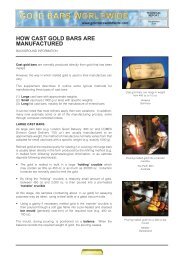Indian Gold Book:Indian Gold Book - Gold Bars Worldwide
Indian Gold Book:Indian Gold Book - Gold Bars Worldwide
Indian Gold Book:Indian Gold Book - Gold Bars Worldwide
You also want an ePaper? Increase the reach of your titles
YUMPU automatically turns print PDFs into web optimized ePapers that Google loves.
ADORNMENT DIMENSION<br />
<strong>Gold</strong> jewellery is a symbol of wealth, status and good fortune that is underpinned by the Hindu religion.<br />
Weddings<br />
The bride is normally adorned with as much jewellery as the family can afford. Large items tend to be worn by female<br />
guests. For most families, a public display of wealth and financial security at weddings is an age-old tradition and ritual.<br />
Among the wealthy, much bridal jewellery is rarely worn again: stored in one of millions of bank “lockers” (deposit boxes).<br />
Large items tend to be withdrawn only occasionally for important functions.<br />
Daily wear<br />
Jewellery is normally worn by women on a daily basis. Most married women wear an item indicating their married status,<br />
many wearing a mangalsutra or long gold chain. Ancillary gold items can include earrings, finger rings and pairs of bangles.<br />
Adornment-related observations<br />
GOLD JEWELLERY CONSUMERS<br />
“Wearable” jewellery<br />
Economic and social changes during the 1990s have encouraged many women to acquire items, within their bridal<br />
collection or through additional purchases or the exchange of old jewellery, that are suited to a variety of social and<br />
work-related occasions, clothing and lifestyle. This has led to increasing sales of lighter weight and smaller items.<br />
Most retailers view “wearable” jewellery as an important new market segment for the middle class. Wedding jewellery tends<br />
to be heavier, formal and more traditional in design.<br />
“Fashionable” jewellery<br />
For both wedding and “wearable” jewellery, many women are insisting on jewellery with innovative and contemporary<br />
designs.<br />
Machine-made jewellery is becoming more popular. It is light, sleek, modern and available in many stylish designs.<br />
Competition<br />
Although there is economic growth, much disposable income that might previously have been spent on jewellery is now<br />
being absorbed by lifestyle products such as TV’s, white goods, electrical appliances, clothing and holidays. The<br />
joint-family system is also gradually being replaced, especially in urban areas, by nuclear families that tend to be less<br />
conservative and less committed to gold.<br />
Image<br />
<strong>Gold</strong> jewellery’s image remains strong among the middle and lower classes, but the sale of large amounts for adornment<br />
purposes is intertwined with the consumer’s perception of gold as a worthwhile asset.<br />
At the top end, demand has weakened for several reasons. <strong>Gold</strong> jewellery is viewed as “old-fashioned”. The younger<br />
generation appears to be less committed to owning or wearing as much as their parents. Retailers are well aware that they<br />
need to address these issues.<br />
Positive factors<br />
The population and number of marriages increase each year. Economic growth will generate a much larger middle class.<br />
The custom of wearing much jewellery at weddings and important functions is expected to endure for a long time. Personal<br />
purchases of wearable, fashionable and small items of jewellery are expected to increase significantly over time.<br />
Photograph: Alukkas<br />
For many jewellery consumers the gold bangle is the most important product category.<br />
Bangles account on average for about 30% by weight of the gold jewellery sales of large urban retailers.<br />
AN INTRODUCTION TO THE INDIAN GOLD MARKET 115

















